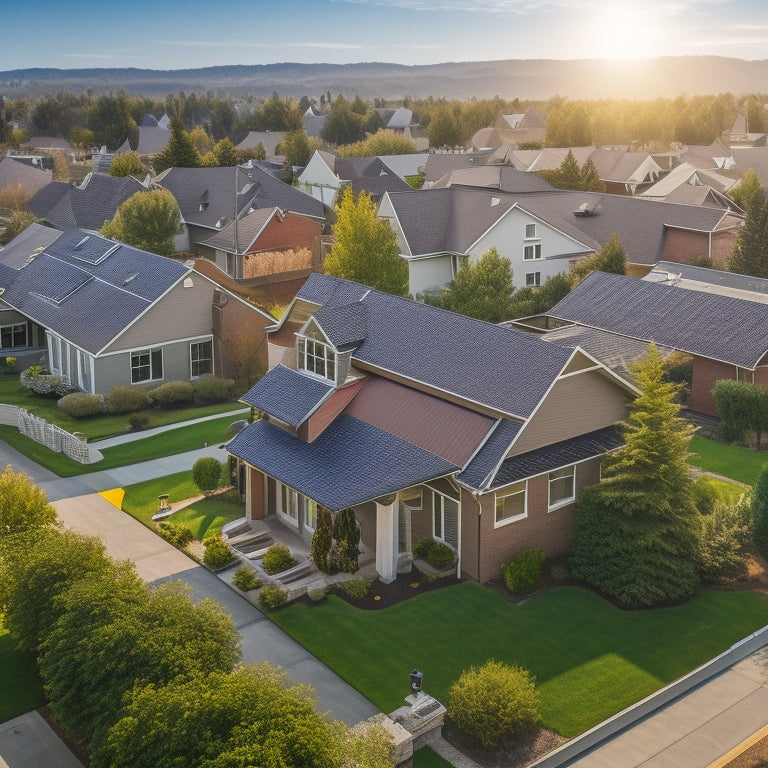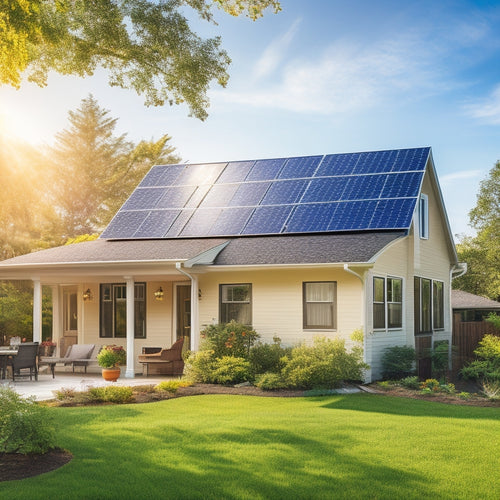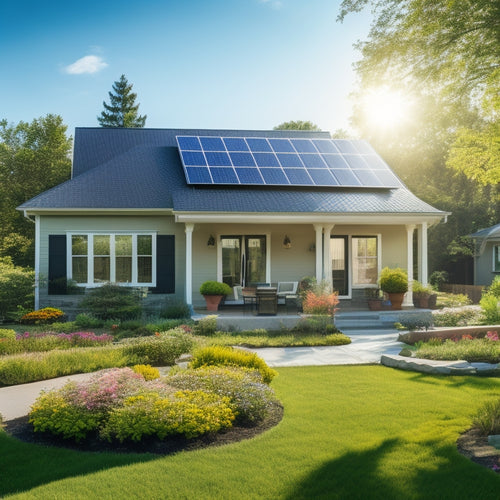
10 Images of Solar Panels Installed on Residential Roofs
Share
You're about to investigate stunning images of solar panels installed on residential roofs, showcasing the ideal blend of form and function as homeowners utilize the power of renewable energy to reduce their carbon footprint. From modern solar panel installation to sleek design ideas, these photos highlight the benefits of rooftop renewable energy systems. You'll see how rooftop solar arrays are carefully planned for best energy production, and how residential solar power solutions can be customized to meet your energy needs. As you take a closer look, you'll uncover the innovative technologies and designs that make solar energy an attractive option for homeowners, and what else you can achieve with a little creativity and knowledge.
Key Takeaways
- Rooftop solar array design requires careful planning for optimal energy production, considering factors like roof size, orientation, and energy needs.
- High-quality solar panels and installation techniques ensure performance, longevity, and compliance with local building codes and environmental factors.
- Residential solar power solutions include grid-tied, off-grid, and hybrid systems, each with unique benefits and considerations for energy independence and savings.
- Professional installers provide customized designs to meet energy needs, ensuring watertight seals, secure panel fastening, and weather resistance.
- Aesthetic considerations, such as panel color, type, and orientation, are important for a sleek and modern look that complements home aesthetics.
Modern Solar Panel Installation
As you weigh the benefits of switching to renewable energy, modern solar panel installation has become a highly sought-after solution.
With advancements in solar technology trends, the industry has witnessed a significant shift towards sustainable energy innovations. These innovations have made solar panels more efficient, durable, and affordable. Consequently, homeowners are increasingly adopting solar power as a viable alternative to traditional energy sources.
Modern solar panel installation involves a thorough approach, considering factors such as roof size, orientation, and energy requirements. Installers assess your energy needs and design a customized system to maximize energy production.
They use high-quality components, ensuring peak performance and longevity. Additionally, many installers offer monitoring services, enabling you to track your energy production and consumption in real-time.
Rooftop Solar Array Design
Your rooftop solar array layout is a critical component of your modern solar panel installation. It involves more than just placing solar panels on your roof; it requires careful planning and contemplation of several factors. A well-designed solar array can maximize energy production, enhance your roof's aesthetic appeal, and guarantee a safe and durable installation.
When designing your rooftop solar array, you'll need to take into account aesthetic considerations, such as the color and type of panels, as well as their orientation and layout. You'll also need to choose the right installation techniques, such as roof-mounted or ground-mounted systems, to ensure a secure and efficient installation.
The design should also take into account local building codes, regulations, and environmental factors, such as shading and wind loads.
A professional solar installer can help you create a customized design that meets your energy needs and complements your home's design. By incorporating the right design elements and installation techniques, you can enjoy a high-performing solar array that provides you with clean, renewable energy for years to come.
Residential Solar Panel Systems
Installing residential solar panel systems is a popular choice for homeowners seeking to reduce their reliance on traditional energy sources and lower their carbon footprint. As you consider converting to renewable energy, it is crucial to understand the benefits and costs associated with residential solar panel systems.
| Solar Incentives | Installation Costs | Payback Period |
|---|---|---|
| 30% Federal Tax Credit | $15,000 - $30,000 | 5-7 years |
| State and Local Rebates | $10,000 - $20,000 | 3-5 years |
| Net Metering Programs | $5,000 - $10,000 | 2-3 years |
You can take advantage of various solar incentives, such as the 30% Federal Tax Credit, state and local rebates, and net metering programs, which can greatly reduce the installation costs. The payback period varies depending on the incentives and installation costs, but you can typically expect to break even within 5-7 years. By investing in a residential solar panel system, you'll not only reduce your energy bills but also increase your property value and contribute to a sustainable future.
Solar Roof Tiles in Action
You're about to see solar roof tiles in action, where solar energy integration meets seamless roof design.
These innovative tiles not only generate energy but also replace traditional roofing materials, creating a sleek, modern look.
As you investigate these images, pay attention to how they efficiently harvest energy while maintaining a durable, weather-tight seal.
Solar Energy Integration
Many modern homes now feature sleek, high-efficiency solar roof tiles, seamlessly integrating solar energy harvesting into their structural design. You're not just getting a stylish roof; you're also generating clean energy and reducing your carbon footprint.
As you investigate solar energy integration, you'll find that it's not just about installing solar panels – it's about creating an all-encompassing system that works in harmony with your home's electrical infrastructure.
You'll want to take advantage of solar incentives, such as tax credits and rebates, which can greatly offset the upfront cost of installation. Additionally, familiarize yourself with local energy policies, which may offer net metering or feed-in tariffs that allow you to sell excess energy back to the grid.
Seamless Roof Design
Three key design principles - aesthetics, functionality, and energy efficiency - converge in modern solar roof tiles, allowing homeowners to seamlessly integrate solar energy harvesting into their roof's structural design. This convergence enables you to achieve a seamless roof design that not only generates clean energy but also complements your home's design style.
| Design Considerations | Key Features |
|---|---|
| Aesthetic Appeal | Sleek, modern design that integrates with your roof's design |
| Roof Compatibility | Designed to work with various roof types and angles |
| Installation Challenges | Simplified installation process reduces labor costs and time |
| Energy Efficiency | Optimized energy harvesting through advanced technology |
| Environmental Impact | Reduced carbon footprint and reliance on fossil fuels |
As you consider solar roof tiles, you'll want to weigh factors such as cost considerations, maintenance requirements, and design innovations. With the latest advancements, you can enjoy a hassle-free installation process and long-term energy savings. The market trends suggest a growing demand for solar roof tiles, and with their aesthetic integration, you can increase your property's value while reducing your environmental footprint.
Efficient Energy Harvesting
Most solar roof tiles are capable of utilizing up to 20 watts of power per square foot, making them an efficient means of energy collection. You can expect a high solar panel efficiency from these tiles, which are designed to maximize energy production while minimizing space.
By integrating these tiles into your roof, you'll be capturing the power of the sun to generate electricity for your home.
When it comes to energy collection techniques, solar roof tiles are ahead of the game. They're designed to capture energy from the sun's rays, converting it into usable electricity for your home.
With advanced technology, these tiles can optimize energy production, even on cloudy days or during periods of low sunlight. You'll be surprised at how efficiently they can generate power, reducing your reliance on traditional energy sources.
Efficient Energy Harvesting Systems
You're likely looking for efficient energy harvesting systems that can maximize your solar panel's potential.
That's where energy saving solutions, renewable power systems, and the green home initiative come in - designed to optimize your energy output and reduce your carbon footprint.
Energy Saving Solutions
As we investigate the domain of energy saving solutions, it becomes increasingly evident that efficient energy harvesting systems play an important role in reducing our reliance on fossil fuels and mitigating climate change. You're likely aware that solar panels on residential roofs are a vital component of this effort. However, it's important to reflect on the broader scope of energy saving solutions. This includes conducting energy audits to identify areas of inefficiency in your home, as well as exploring solar incentives that can help offset the cost of installation.
| Solution | Description | Benefits |
|---|---|---|
| Energy Audits | Thorough assessment of energy usage | Identifies areas for improvement, reduces energy waste |
| Solar Incentives | Government-backed programs for solar adoption | Reduces upfront costs, increases ROI |
| Energy-Efficient Appliances | Appliances designed to minimize energy consumption | Reduces energy waste, lowers utility bills |
| Smart Home Systems | Integrated systems for energy management | Optimizes energy usage, enhances convenience |
| Building Insulation | Materials designed to reduce heat transfer | Reduces energy loss, increases comfort |
Renewable Power Systems
Beyond exploring the domain of energy saving solutions, your focus now shifts to the implementation of renewable power systems, a vital step in utilizing energy efficiently.
These systems enable you to capture the power of solar energy, reducing your reliance on the grid and your environmental impact. With solar incentives and rebates, the cost of installation is decreasing, making it more accessible to homeowners.
You can opt for community solar programs, where multiple individuals share the benefits of a single solar array. Grid integration allows you to sell excess energy back to the grid, and net metering tracks your energy production and consumption.
Energy storage solutions guarantee a steady supply of power, even during periods of low sunlight. Solar financing options and power purchase agreements can help you overcome the initial investment.
By investing in renewable power systems, you're not only reducing your energy bills but also contributing to a sustainable future.
Through solar education and awareness, you can make informed decisions about your energy needs and take a step towards a cleaner, greener tomorrow.
Green Home Initiative
The Green Home Initiative is a thorough approach to changing your residence into an eco-friendly haven, where efficient energy collection systems take center stage. By incorporating green technology, you'll not only reduce your carbon footprint but also save on energy costs. This initiative is all about sustainable living, and it starts with your roof.
As you consider installing solar panels, you'll want to know the benefits. Here's a breakdown:
| Benefits | Description |
|---|---|
| Energy Savings | Reduce your energy bills by utilizing free energy from the sun |
| Environmental Impact | Lower your carbon footprint and contribute to a cleaner environment |
| Increased Property Value | Enhance your property's value with a modern, eco-friendly feature |
With the Green Home Initiative, you'll be taking a significant step towards a more sustainable future. By investing in efficient energy collection systems, you'll be doing your part for the environment while also reaping the financial benefits.
Solar Panels on Clay Tiles
Installing solar panels on clay tiles requires careful evaluation of the roofing material's unique characteristics. You'll need to guarantee the panels are securely fastened to the tiles without compromising their integrity.
Clay tiles are more prone to breakage than other roofing materials, so it's vital to handle them with care during the installation process.
The installation challenges don't stop there. You'll also need to take into account the tile's uneven surface, which can make it difficult to achieve a uniform panel installation.
Additionally, the weight of the panels and their mounting system must be carefully distributed to avoid putting excessive pressure on the tiles.
Aesthetic considerations are also significant when installing solar panels on clay tiles. The panels should be strategically placed to maintain the roof's original appearance.
You may need to use specialized mounting systems or adjust the panel's angle to guarantee a seamless integration with the existing roof design.
Residential Solar Power Solutions
You'll need to contemplate system design options that work best for your residential solar power system, factoring in elements like roof size, local building codes, and energy usage patterns.
By doing so, you can optimize energy savings benefits, such as reduced electricity bills and a lower carbon footprint.
With the right design and installation, you can maximize the return on your investment in residential solar power.
System Design Options
Most residential solar power systems rely on one of three primary system design options: grid-tied, off-grid, or hybrid.
You'll want to evaluate each option carefully, as they impact system efficiency and design aesthetics.
Grid-tied systems connect to the grid, allowing you to sell excess energy back to the utility company. This option is ideal for homes already connected to the grid, as it maximizes system efficiency and provides a seamless integration with your existing energy infrastructure.
However, it does require a grid connection, which may not be feasible in remote areas.
Off-grid systems, on the other hand, operate independently of the grid, making them suitable for remote or rural areas. While they offer greater energy independence, they often require larger battery banks and more complex system designs, which can increase costs.
Hybrid systems combine the benefits of both, allowing you to store excess energy for later use while still maintaining a grid connection. This option provides a balance between energy independence and grid reliability, making it an attractive choice for many homeowners.
Energy Savings Benefits
As you evaluate the pros and cons of each system design option, the potential energy savings benefits of residential solar power solutions likely play a notable role in your decision-making process.
One of the primary advantages of installing solar panels on your roof is the considerable reduction in your energy bills. By utilizing the power of the sun, you can generate electricity and reduce your reliance on the grid, leading to substantial cost savings over time.
Here are some key energy savings benefits to reflect upon:
-
Reduced energy bills: With solar power, you can markedly lower your energy bills, saving you money that can be better allocated elsewhere.
-
Increased energy independence: By generating your own electricity, you're less dependent on the grid, giving you more control over your energy usage and costs.
-
Long-term savings: While the initial installation cost may seem high, the long-term savings from reduced energy bills can offset this investment over time, making it a worthwhile cost analysis.
- Government installation incentives: Many governments offer installation incentives, such as tax credits or rebates, to encourage the adoption of residential solar power solutions, further sweetening the deal.
Sleek Solar Panel Design Ideas
When incorporating solar panels into your roof design, sleek aesthetics can be just as important as energy efficiency. You want your solar panels to blend seamlessly into your roof's design, not stand out as an eyesore. To achieve this, consider the following sleek solar panel design ideas:
| Design Element | Description | Benefit |
|---|---|---|
| Thin Frames | Slim, minimalist frames that blend into the roofline | Unobtrusive, modern look |
| Integrated Racking | Racking systems that integrate with the roof's design | Streamlined appearance, reduced visibility |
| Black Frames | Frames that match the color of the solar panels | Sleek, high-tech appearance |
Innovative materials and technologies have made it possible to achieve minimalist aesthetics without compromising energy efficiency. You can choose from a range of frame colors and styles to match your roof's design. Additionally, consider using solar panels with high-efficiency cells to maximize energy production while minimizing the number of panels needed, resulting in a cleaner, more streamlined appearance. By incorporating these design elements, you can create a roof that not only generates clean energy but also adds to your home's curb appeal.
Rooftop Renewable Energy Systems
Rooftop renewable energy systems, which include solar panels, solar shingles, and other innovative technologies, are changing the way homeowners generate clean energy.
You're likely considering investing in a rooftop renewable energy system to reduce your reliance on the grid and minimize your environmental impact. With solar incentives and financing options available, it's more accessible than ever.
Some benefits of rooftop renewable energy systems include:
- Energy independence: Generate your own clean energy and reduce your reliance on the grid.
- Grid integration: Sell excess energy back to the grid and offset your energy costs through net metering.
- Community solar: Participate in community solar programs and share the benefits of renewable energy with your neighbors.
- Energy resilience: guarantee a steady supply of energy, even during outages, with a smart home system.
When considering a rooftop renewable energy system, you'll need to weigh the installation challenges against the long-term benefits.
With the right system, you can enjoy a reduced environmental impact, increased energy independence, and a more resilient energy supply.
Solar Panels on Asphalt Shingles
You're likely familiar with asphalt shingles, a common roofing material used in many homes. When it comes to installing solar panels on asphalt shingles, there are some key considerations to keep in mind.
From a solar panel aesthetics viewpoint, asphalt shingles provide a relatively straightforward installation process, allowing for a seamless integration of the panels into the existing roofline. However, installation challenges arise when it comes to guaranteeing a watertight seal around the mounting system. This is vital to prevent water ingress and potential damage to the roof or solar panels.
To overcome these challenges, installers typically use specialized flashing and sealants to create a watertight seal around the mounting system. This may add complexity to the installation process, but it's important to confirm the long-term performance and reliability of the solar panel system.
Additionally, installers must also verify that the solar panels are securely fastened to the roof to withstand various weather conditions, including high winds and heavy snow loads. By addressing these installation challenges, homeowners can enjoy a reliable and efficient source of renewable energy while maintaining the integrity of their asphalt shingle roof.
Frequently Asked Questions
Can Solar Panels Be Installed on Metal Roofs?
You're wondering if solar panels can be installed on a metal roof. Yes, they can! Metal roof advantages include durability and weather-tightness, but installation considerations involve ensuring compatible mounting systems and addressing potential corrosion risks.
Do Solar Panels Work During Power Outages?
You're wondering if solar panels work during power outages; the answer is, they don't - unless you have a battery backup system. With one, you'll enjoy power independence, utilizing solar energy even when the grid goes down.
Are Solar Panels Environmentally Friendly?
You might think solar panels aren't environmentally friendly due to production emissions, but you'll find they offset these costs within 3-5 years of operation, providing clean energy and numerous solar panel benefits while minimizing environmental impact.
Can I Install Solar Panels Myself?
You can attempt a DIY solar panel installation, but it's essential to weigh the risks and rewards, as improper installation can void warranties and compromise system efficiency; consider consulting a professional for a successful DIY solar project.
Do Solar Panels Increase Property Taxes?
You're wondering if going solar will hike your property taxes; the answer is, it depends. While solar panels enhance property value, you're likely to benefit from solar tax incentives, which can offset increased taxes, leaving you with a worthwhile investment.
Conclusion
You've seen the versatility of solar panels on residential roofs, from sleek designs to efficient energy harvesting systems. As you consider your own solar power solution, keep in mind that the average American home can save up to $500 per year on electricity bills by installing solar panels. With the cost of solar energy decreasing by 70% over the past decade, it's an investment worth exploring for a sustainable future.
Related Posts
-

How to Finance Home Solar Panels
Financing home solar panels offers several strategies to lighten your initial costs while maximizing long-term benefi...
-

High-Performance Energy-Efficient HVAC Systems
High-performance energy-efficient HVAC systems are essential for reducing energy consumption while improving indoor c...
-

Affordable Solar Panels for Home Use
Affordable solar panels offer you a smart way to cut down on energy costs while promoting sustainability. With govern...


